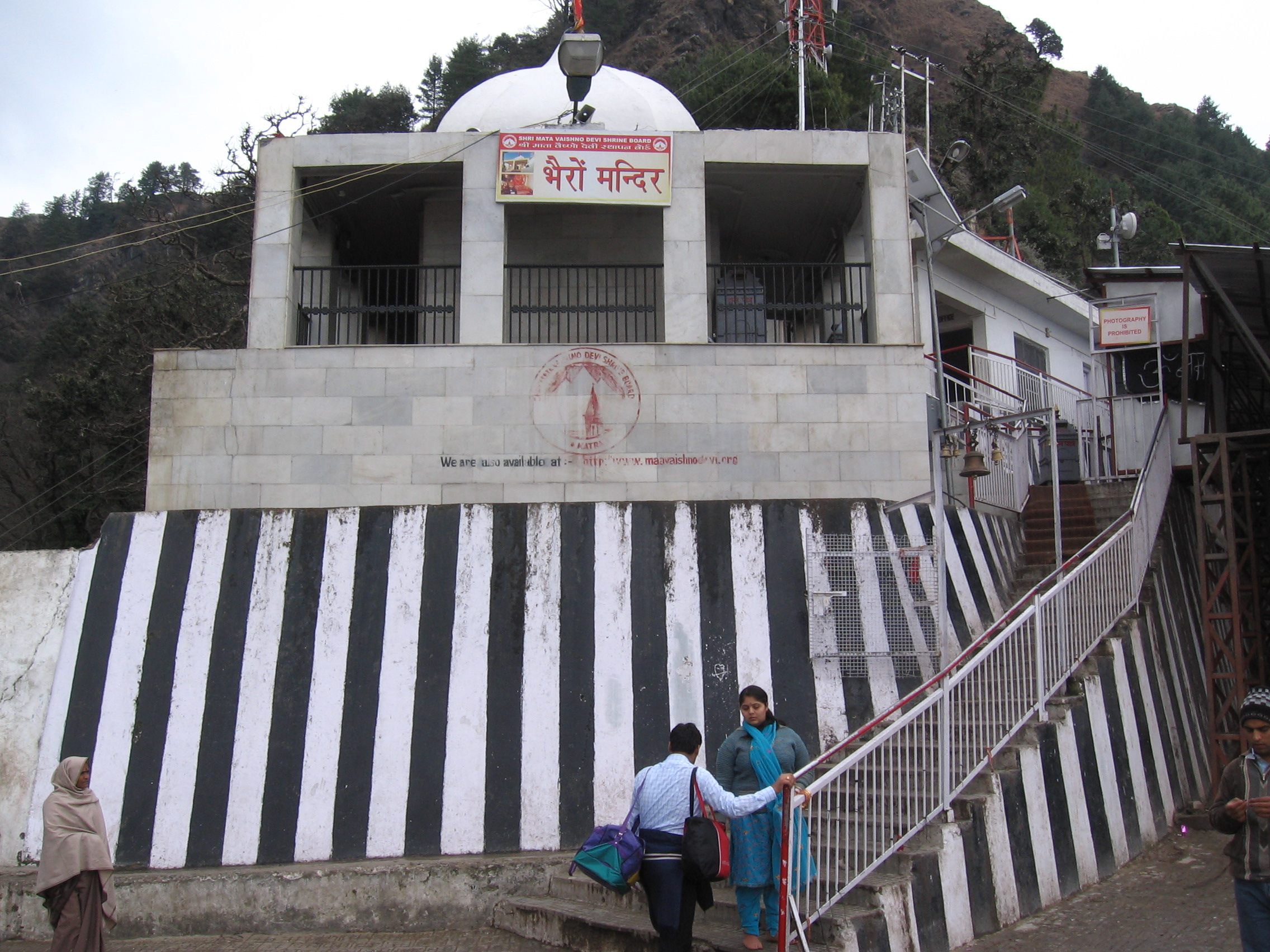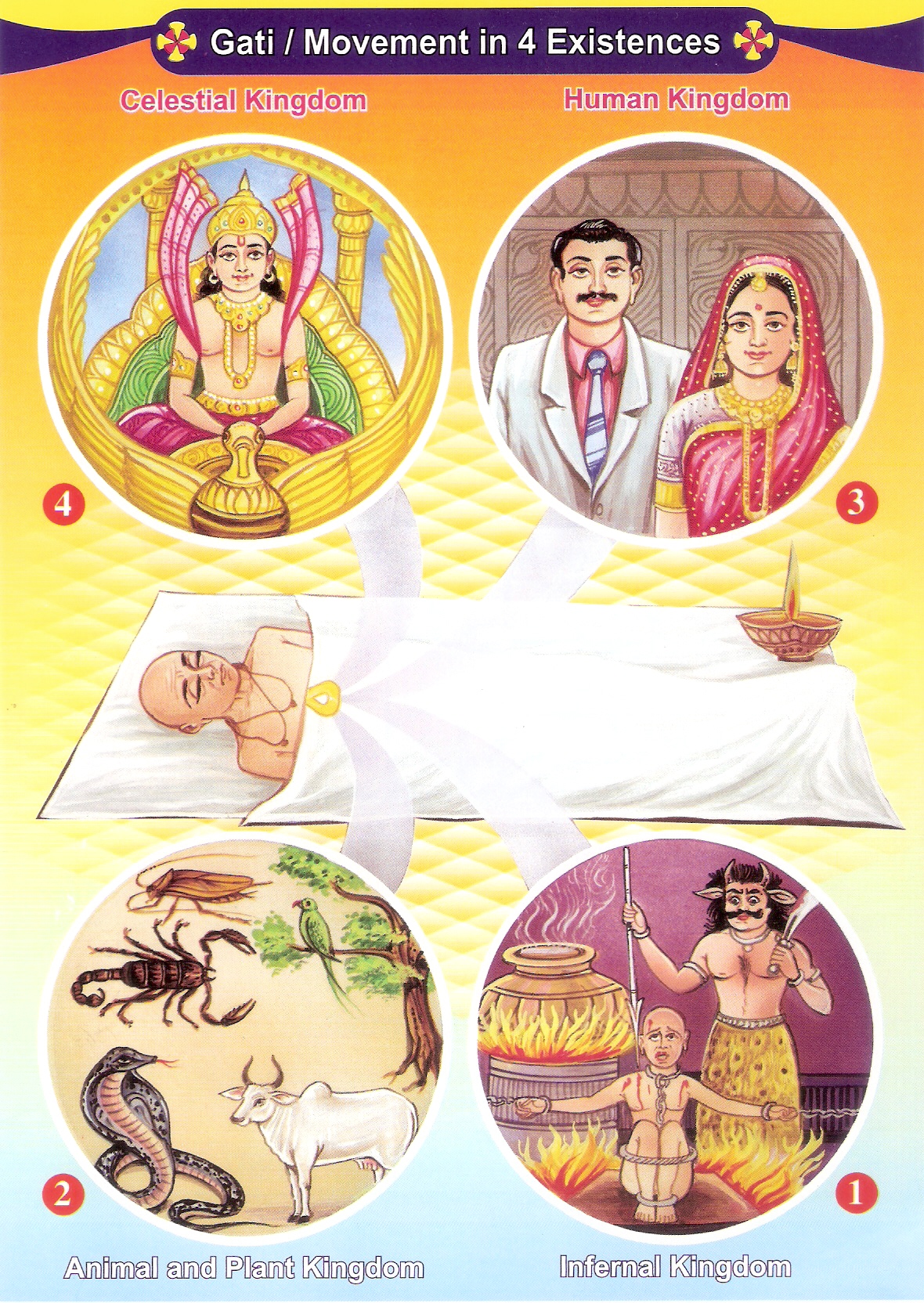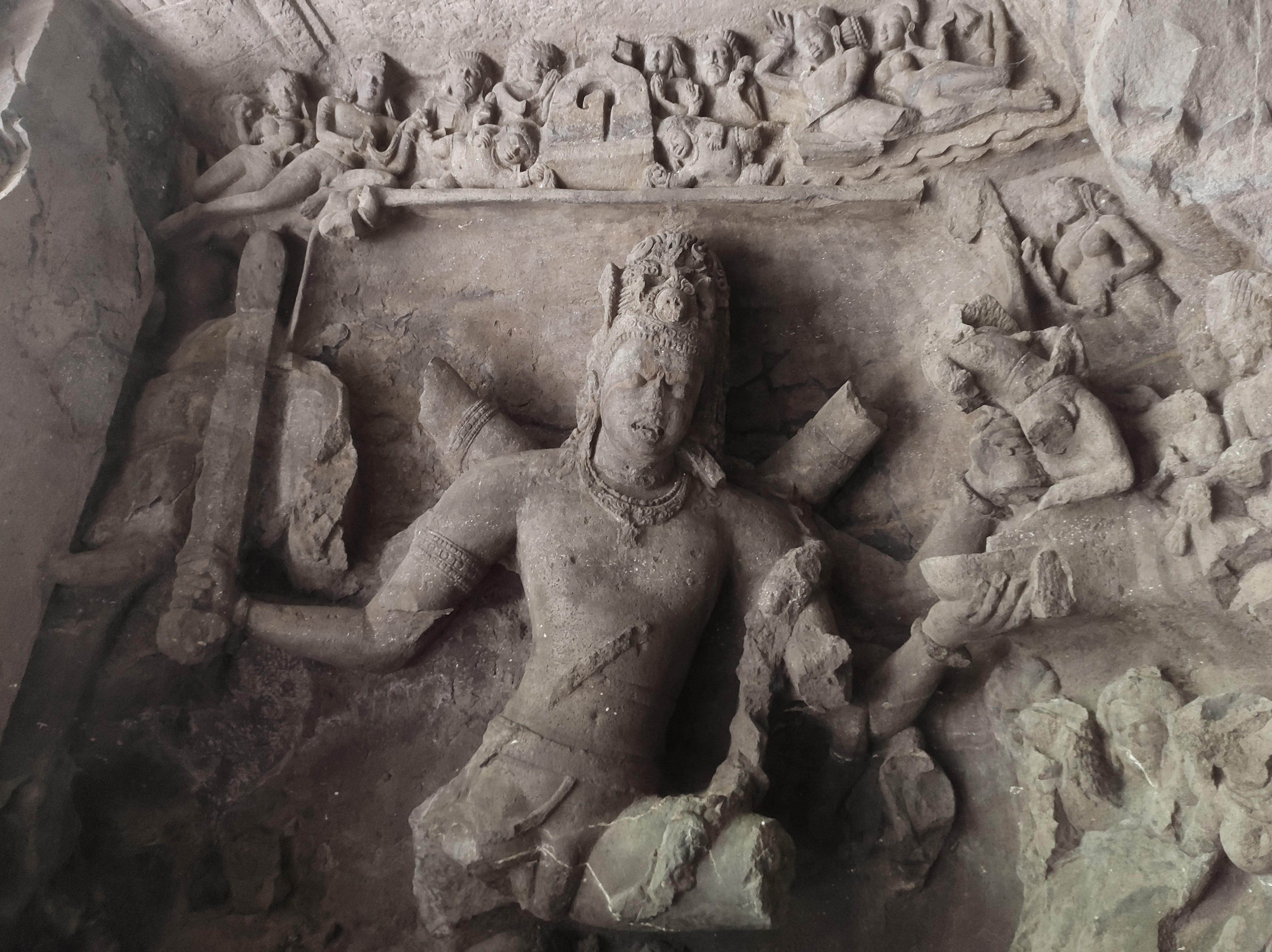|
Bhairav (tantrik)
Bhairav or Bhairavnath (alternatively Bhairon or Bhaironnath) was a disciple of Gorakhnath, whose guru was the Matsyendranath. He was considered to have control over all tantrik siddhis and had grown arrogant of his power. He went after Vaishno Devi, considering her to be a little girl. It was only when mata Vaishno Devi took the form of Kali and behead Bhairav and in last he realized her true form and asked for forgiveness. In his dying moments, Bhairav pleaded for forgiveness. The Goddess knew that Bhairav's main intention in attacking her was to achieve his salvation. She not only granted Bhairav liberation from the cycle of reincarnation, but also granted him a boon, whereby every devotee, in order to ensure completion of the pilgrimage of Vaishno Devi, shall also have to visit Bhairav Nath's temple near the Holy cave after having the darshan of the Goddess. There are many temples of Baba Bhairava ( Shiva's incarnation) in India especially in Ujjain and Varanasi. The only templ ... [...More Info...] [...Related Items...] OR: [Wikipedia] [Google] [Baidu] |
Gorakhnath
Gorakhnath (also known as Gorakshanath (Sanskrit: ''Gorakṣanātha'') (Devanagari : गोरक्षनाथ / गोरखनाथ), c. early 11th century) was a Hindu yogi, mahasiddha and saint who was the founder of the Nath Hindu monastic movement in India. He is considered one of the two disciples of Matsyendranath. His followers are known as Jogi, ''Gorakhnathi'', ''Darshani'' or ''Kanphata''. He was one of nine saints, or Navnath, and is known in Maharashtra, India. Hagiographies describe him to be a person outside the laws of time who appeared on earth during different ages. Historians agree that Gorakhnath lived sometime during the first half of the 2nd millennium CE, but there is some disagreement about which century he lived. Estimates based on archaeological and textual evidence range from Briggs' estimate of the 11th to 12th century to Grierson's estimate of the 14th century. Gorakhnath is considered a ''Maha-yogi'' (or "great yogi") in Hindu tradition. He d ... [...More Info...] [...Related Items...] OR: [Wikipedia] [Google] [Baidu] |
Guru
Guru ( ; International Alphabet of Sanskrit Transliteration, IAST: ''guru'') is a Sanskrit term for a "mentor, guide, expert, or master" of certain knowledge or field. In pan-Indian religions, Indian traditions, a guru is more than a teacher: traditionally, the guru is a reverential figure to the disciple (or ''wikt:शिष्य, shisya'' in Sanskrit, literally ''seeker [of knowledge or truth'']) or student, with the guru serving as a "counsellor, who helps mould values, shares experiential knowledge as much as Knowledge#Hinduism, literal knowledge, an Role model, exemplar in life, an inspirational source and who helps in the spiritual evolution of a student". Whatever language it is written in, Judith Simmer-Brown says that a tantra, tantric spiritual text is often codified in an obscure twilight language so that it cannot be understood by anyone without the verbal explanation of a qualified teacher, the guru. A guru is also one's spiritual guide, who helps one to discover the ... [...More Info...] [...Related Items...] OR: [Wikipedia] [Google] [Baidu] |
Matsyendranath
Matsyendranātha, also known as Matsyendra, Macchindranāth, Mīnanātha and Minapa (early 10th century) was a saint and yogi in a number of Buddhism, Buddhist and Hinduism, Hindu traditions. He is considered the revivalist of hatha yoga as well as the author of some of its earliest texts. He is also seen as the founder of the natha ''sampradaya'', having received the teachings from Shiva. He is associated with Kaula (Hinduism), Kaula Shaivism. He is also one of the eighty-four mahasiddhas and considered the guru of Gorakshanath, another known figure in early hatha yoga. He is revered by both Hindus and Buddhists and is sometimes regarded as an incarnation of Avalokiteśvara. In the Siddhar tradition of Tamil Nadu, Matsyendranath is revered as one of the 18 Siddhars of yore, and is also known as Machamuni. The Kasi Viswanathar Temple in Thiruparankundram, Madurai, Tamil Nadu is home to his Jiva, Jeeva Samadhi. Early life Little is known about the life of Matsyendra: he is also ... [...More Info...] [...Related Items...] OR: [Wikipedia] [Google] [Baidu] |
Siddhi
In Indian religions, (Sanskrit: '; fulfillment, accomplishment) are material, paranormal, supernatural, or otherwise magical powers, abilities, and attainments that are the products of Yoga, yogic advancement through sādhanās such as meditation and yoga. The term ṛddhi (Pali: ''iddhi'', "psychic powers") is often used interchangeably in Buddhism. Etymology ''Siddhi'' is a Sanskrit noun which can be translated as "knowledge", "accomplishment", "attainment", or "success". Method The ''Visuddhimagga'' is one of the texts to give explicit details about how spiritual masters were thought to actually manifest supernormal abilities. It states that abilities such as flying through the air, walking through solid obstructions, diving into the ground, walking on water and so forth are achieved through changing one Mahābhūta, element, such as earth, into another element, such as air. The individual must master ''kasina'' meditation before this is possible. Dipa Ma, who trained vi ... [...More Info...] [...Related Items...] OR: [Wikipedia] [Google] [Baidu] |
Vaishno Devi
Vaishno Devi (also known as Mata Rani, Trikuta, Ambe and Vaishnavi) is a manifestation of the Hindu mother goddess. She is worshipped as a combined avatar of the goddesses Mahakali, Mahalakshmi, and Mahasarasvati. Origin Purāṇa In the Varāha Purāṇa's Triśakti Māhātmya, she originated from the goddess Trikalā and slayed the asura Mahiṣāsura on Śataśṛṅga Parvata where the current Trikūṭa Dhāma of Vaiṣṇōdēvī is situated. Pāñcarātra The Lakṣmīnārāyaṇa Saṃhitā's Kṛtayuga Santāna and Dvāparayuga Santāna calls her "Māṇikī", the Śakti of Kalki, as she resides on Māṇika Parvata. Mythology It is said that when Bhairavnath ran after Vaishno Devi to catch her, she approached a cave in the hills and summoned Hanuman. She told him, "I would do penance in this cave for nine months, till then you should not allow Bhairavnath to enter the cave." Hanuman obeyed her orders. Today the cave is known as Ardha Kunwari. Temple ... [...More Info...] [...Related Items...] OR: [Wikipedia] [Google] [Baidu] |
Kali
Kali (; , ), also called Kalika, is a major goddess in Hinduism, primarily associated with time, death and destruction. Kali is also connected with transcendental knowledge and is the first of the ten Mahavidyas, a group of goddesses who provide liberating knowledge. Of the numerous Hindu goddesses, Kali is held as the most famous. She is the preeminent deity in the Hindu tantric and the Kalikula worship traditions, and is a central figure in the goddess-centric sects of Hinduism as well as in Shaivism. Kali is chiefly worshipped as the Divine Mother, Mother of the Universe, and Divine feminine energy. The origins of Kali can be traced to the pre-Vedic and Vedic era goddess worship traditions in the Indian subcontinent. Etymologically, the term ''Kali'' refers to one who governs time or is black. The first major appearance of Kali in the Sanskrit literature was in the sixth-century CE text '' Devi Mahatmya''. Kali appears in many stories, with the most popular one bein ... [...More Info...] [...Related Items...] OR: [Wikipedia] [Google] [Baidu] |
Reincarnation
Reincarnation, also known as rebirth or transmigration, is the Philosophy, philosophical or Religion, religious concept that the non-physical essence of a living being begins a new lifespan (other), lifespan in a different physical form or physical body, body after biological death. In most beliefs involving reincarnation, the soul of a human being is immortality, immortal and does not disperse after the physical body has perished. Upon death, the soul merely becomes transmigrated into a newborn baby or into an animal to continue its immortality. (The term "transmigration" means the passing of a soul from one body to another after death.) Reincarnation (''punarjanman'') is a central tenet of Indian religions such as Hinduism, Buddhism, Jainism, and Sikhism. In various forms, it occurs as an esoteric belief in many streams of Judaism, in certain Paganism, pagan religions (including Wicca), and in some beliefs of the Indigenous peoples of the Americas and of Australian ... [...More Info...] [...Related Items...] OR: [Wikipedia] [Google] [Baidu] |
Darśana
In Indian religions, a ''darshan'' (Sanskrit: दर्शन, ; 'showing, appearance, view, sight') or ''darshanam'' is the auspicious sight of a deity or a holy person. The term also refers to any one of the six traditional schools of Hindu philosophy and their literature on spirituality and soteriology. Etymology The word ''darshana'', also in the forms of ''darśana'' or ''darshanam'', comes from the Sanskrit root of दर्शन ''dṛś'' 'to look at', 'to view', vision, apparition or glimpse. Definition ''Darshana'' is described as an "auspicious sight" of a holy person, which bestows merit on the viewer. It is most commonly used for theophany, meaning a manifestation or vision of the divine. In Hinduism In Hindu worship, it refers to seeing a deity (especially in image form), or a very holy person or artifact. One can receive ''darshana'' or a glimpse of the deity in the temple, or from a great saintly person, such as a great guru. One can also take ''darshana ... [...More Info...] [...Related Items...] OR: [Wikipedia] [Google] [Baidu] |
Bhairava
Bhairava (, ), or Kāla Bhairava, is a Shaivite and Vajrayāna deity worshipped by Hindus and Buddhists. In Shaivism, he is a powerful manifestation, or avatar, of Shiva.Kramrisch, Stella (1994). ''The Presence of Śiva''. Princeton, NJ: Princeton University Press. p. 471. In the tradition of Kashmir Shaivism, Bhairava represents the Supreme Reality, synonymous to Para Brahman. Generally in Hinduism, Bhairava is also called Dandapāni (" e who holds thedanda in ishand"), as he holds a rod or ''danda'' to punish sinners, and Svaśva, meaning, "he whose vehicle is a dog". In Vajrayana Buddhism, he is considered a fierce emanation of boddhisatva Mañjuśrī, and also called Heruka, Vajrabhairava, Mahākāla and Yamantaka. Bhairava is worshipped throughout India, Nepal, Indonesia, Sri Lanka, and Japan, as well as in Tibetan Buddhism. Etymology Bhairava originates from the word ''bhīru'', which means "fearsome". Bhairava means "terribly fearsome form". It is also kn ... [...More Info...] [...Related Items...] OR: [Wikipedia] [Google] [Baidu] |
Shiva
Shiva (; , ), also known as Mahadeva (; , , Help:IPA/Sanskrit, [mɐɦaːd̪eːʋɐh]) and Hara, is one of the Hindu deities, principal deities of Hinduism. He is the God in Hinduism, Supreme Being in Shaivism, one of the major traditions within Hinduism. Shiva is known as ''The Destroyer'' within the Trimurti, the Hinduism, Hindu trinity which also includes Brahma and Vishnu. In the Shaivite tradition, Shiva is the Supreme Lord who creates, protects and transforms the universe. In the goddess-oriented Shaktism, Shakta tradition, the Supreme Goddess (Devi) is regarded as the energy and creative power (Shakti) and the equal complementary partner of Shiva. Shiva is one of the five equivalent deities in Panchayatana puja of the Smarta Tradition, Smarta tradition of Hinduism. Shiva has many aspects, benevolent as well as fearsome. In benevolent aspects, he is depicted as an Omniscience, omniscient yogi who lives an Asceticism#Hinduism, ascetic life on Kailasa as well as a house ... [...More Info...] [...Related Items...] OR: [Wikipedia] [Google] [Baidu] |
Ujjain
Ujjain (, , old name Avantika, ) or Ujjayinī is a city in Ujjain district of the Indian state of Madhya Pradesh. It is the fifth-largest city in Madhya Pradesh by population and is the administrative as well as religious centre of Ujjain district and Ujjain division. It is one of the Hindu pilgrimage centres of Sapta Puri famous for the ''Kumbh Mela'' (Simhastha) held there every 12 years. The ancient and world famous temple of Mahakaleshwar Jyotirlinga is located in the center of the city. The city has been one of the most prominent trade and political centres of the Indian Subcontinent from the time of the ancient Mahājanapadas until the British colonisation of India. An ancient city situated on the eastern bank of the Shipra River, Ujjain was the most prominent city on the Malwa plateau of central India for much of its history. It emerged as the political centre of central India around 600 BCE. It was the capital of the ancient Avanti kingdom, one of the sixteen ... [...More Info...] [...Related Items...] OR: [Wikipedia] [Google] [Baidu] |
Varanasi
Varanasi (, also Benares, Banaras ) or Kashi, is a city on the Ganges river in northern India that has a central place in the traditions of pilgrimage, death, and mourning in the Hindu world.* * * * The city has a syncretic tradition of Islamic artisanship that underpins its religious tourism.* * * * * Located in the middle-Ganges valley in the southeastern part of the state of Uttar Pradesh, Varanasi lies on the left bank of the river. It is to the southeast of India's capital New Delhi and to the southeast of the state capital, Lucknow. It lies downstream of Prayagraj, where the confluence with the Yamuna river is another major Hindu pilgrimage site. Varanasi is one of the world's oldest continually inhabited cities. Kashi, its ancient name, was associated with a kingdom of the same name of 2,500 years ago. The Lion capital of Ashoka at nearby Sarnath has been interpreted to be a commemoration of the Buddha's first sermon there in the fifth century BCE. In the ... [...More Info...] [...Related Items...] OR: [Wikipedia] [Google] [Baidu] |











